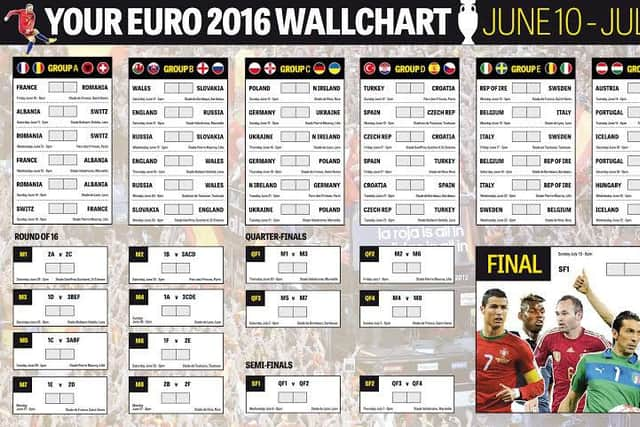Endless possibilities for Euro 2016 chart-toppers


That first time you look upon one every two years, the names and numbers assembled in order, the endless permutations beyond the group stage, the storylines poised to be unravelled.
If a current of electricity does not course through your veins then football is not in your blood.


Advertisement
Hide AdAdvertisement
Hide AdWallcharts transcend generations. From the first time your dad allows you to stick one on your bedroom wall, to the one you persuade your teacher to let you plaster on the blackboard.
Years later it is cellotaped to the office wall, a colleague taking their time over where best to place it, knowing within minutes he will be joined by other like-minded individuals and the banter will begin.
For the next month, that spot in the office will become a focal point. The boss need not know.
Who is bequeathed with the honour of filling it in? Is it a lone scribe or a team of trusted allies?


No one who might desecrate it is allowed near it.
Advertisement
Hide AdAdvertisement
Hide AdMore than ever, the wallchart for Euro 2016 must be obeyed. It is not one to be taken lightly.
This is no tournament with 16 or 32 teams, a simple equation of the top two teams advancing to the knockout stages.
There will be none of the straightforward maths of A1 meets B2 in France over the coming weeks. No, in all their wisdom – or rather their desire to make more money – UEFA decided that a continental championship, which with 16 teams had produced some thrilling tournaments, needed expanding by eight teams and one week.
So, for the first time, the European Championships will be contested by 24 nations, 16 of which will advance to the knockout stage.
Advertisement
Hide AdAdvertisement
Hide AdA second round has been created, meaning the four third-place teams with the highest points total will progress from the opening stanza.
Trying to plot an eventual winner, which is part of the fun of a tournament wallchart, is nigh on impossible.
Take England’s potential route, for instance.
If they win Group B comprising themselves, Russia, Wales and Slovakia, it is not as simple as them playing the second-placed team in Group A.
At Euro 2016, they will face either the third-placed team from Group A, C or D at the Parc de Princes in Paris on Saturday, June 25.
Advertisement
Hide AdAdvertisement
Hide AdIf they finish second in the group it is a little more cut and dried – the runner-up in Group F in Nice on Monday, June 27, which could be any of Portugal, Iceland, Hungary or Austria.
Should Roy Hodgson’s men finish third and require a strong record to progress, then they could find themselves either in Lille on Saturday, June 25, against the winner of Spain’s pool, or in Lille 24 hours later squaring off with the team who emerge top of Germany’s group. So Germany then.
Unless Northern Ireland, spring the mother of all surprises and top what is a dangerous-looking Group C alongside Poland and Ukraine as well.
But if Michael O’Neill’s side are to win just one group game, thus giving them a chance of progressing, then the format of this summer’s European Championships decrees that they could meet anyone.
Advertisement
Hide AdAdvertisement
Hide AdIn fact, any country that progresses could face one of up to 16 nations in the second round.
There are only groups that they do not match with, meaning there is no such thing as a ‘half of the draw’ in this tournament.
You follow that? Me neither.
But that does not mean we have to look upon a wallchart and not look ahead.
Once the second round of fixtures is determined, a route to the Stade de France in Saint Denis for the final on Sunday, July 10, can be plotted.
Advertisement
Hide AdAdvertisement
Hide AdIf anything, this is the wallchart that keeps on giving, because you can come back to it and start all over again.
Who knows what the next month will hold?
Who will be champions; who will head home with their tails between their legs?
Who will flatter to deceive, and more excitedly, who will emerge as a continental star?
Who will be the James Rodriquez of Euro 2016? The Colombian was arguably the best player at the 2014 World Cup in Brazil – who from the 24 nations will capture our hearts as he did in the land of samba soccer?
How far will England go? The quarter-final? All the way?
That’s the beauty of a wallchart – the possibilities are endless.